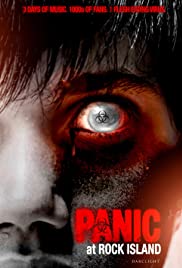
PANIC AT ROCK ISLAND
Australia, 2011, 95 minutes, Colour,
Grant Bowler, Zoe Cramond, Eli Kent, Vince Colosimo, Damien Walshe- Howling, Marshall Napier, Dee Smart, Jessica Tovey.
Directed by Tony Tilse.
Panic at Rock Island is a lavishly staged disaster film. The setting is Sydney Harbour, an island near the Harbour Bridge, and the staging of a rock concert which has drawn a large audience.
In the meantime, two young people (from New Zealand – there was New Zealand money in the production), have discovered a dying man in underground tunnels. When the authorities are alerted, it emerges that there is a virus on the loose, quickly contagious. A growing number of people are taken ill on the island and the police and with the meagre medical resources try to cope.
In the meantime, Jim Quinn, the medical advisor to the New South Wales government, has been in clashes with the Minister and the Premier about precautions being taken for quarantine and care about infections and their spread. He has to take charge of the investigations – which involve an expert in military matters from Vietnam (Vince Colosimo). This links in with the opening sequence in Afghanistan and a man with some kind of virus.
There are the usual political clashes. There are other family concerns, especially when the man in charge finds that his son is not studying and is on the island, and his policewoman daughter is also working there. His anxious wife also makes her way to the island despite military prevention for people moving on or off the island.
The film builds up its sense of drama, the various people who are becoming sick, the desperation of the official and the reaction of the minister and the Premier – who, ultimately, take all the credit for the happier resolution and the alleged lack of panic. There are in fact, quite a number of scenes of panic.
The twist at the end is that the virus has been produced in Sydney itself, by a government sponsored institution, for bioterrorism. The man who was seen in Afghanistan at the beginning of the film, understands the virus and has been trying to expose the makers.
At the end, the media come up with a cover story, exonerating the government and dismissing the man who made the complaints granting him as a terrorist.
Grant Bowler, a New Zealand actor who appeared in The Great Mint Swindle as well as (True Blood and is Richard Burton in thetelemovie Dick and Liz, with Lindsay Lohan), is a sturdy central character. Vince Colosimo is the military advisor who knows more than he communicates.
Steven Soderberg’s Contagion – with similar but vaster scenario was released in 2011.
1. The impact of this kind of disaster film? Audiences identifying with the situations? With the characters? With their behaviour? With the dangers, with possible solutions?
2. The Sydney setting, the harbour, the island, the Harbour Bridge and the scenic points? Atmosphere?
3. The rock concert, the choice of music – and the music played throughout the film?
4. The opening in Afghanistan, the Australians all going down the well, the tunnel, discovering the sick man? The aftermath – his return to Australia, his being cut off from the military? His knowing about the virus? His attempts to expose the situation? His own illness, in the tunnel, dying? His reputation destroyed by the government and the media at the end of the story? A bioterrorist?
5. Jim Quinn, a man of integrity, his skills as a doctor? His political arguments with the Minister, the Premier? The rock artists objecting to the quarantine examination at the beginning? The pragmatic nature of politics? Unwillingness to take risks? Unwillingness to face the facts?
6. The investigator, getting the blood from the island, identifying the virus, communicating it to Jim Quinn? The dim view of the authorities?
7. Jim and his family, his wife, a growing concern about her children on the island, the phone calls, coming into the office, facing the ban, getting a fishing boat, going to the island, knocked into the water by the speedboats? Her getting there, finding her children, Jim?
8. The children: at home, the young woman, police work, on the island, helping out? The boy, his friend, not studying, the mother’s okay to go to the island? The reaction to the virus? The friend, his behaviour, diving into the water, getting to land, being bashed by the military?
9. The the reaction of the young people, the stopping of the concert, their booing, the panic scenes? Cheering on the swimmer to the mainland, aghast at what happened to him?
10. The young New Zealanders, in the tunnel? Not wanting to communicate, the girl telling the truth? The young man, his illness, deterioration moving amongst the people, his death? Her later wanting to get the young people through the tunnel – the authorities flooding it and drowning them?
11. The behaviour of the minister, the behaviour of the Premier? Arguments with Jim? His going over their heads, banning people from leaving the island?
12. His military background, SAS? A federal advisor on terrorism? His knowing Jim? His accompanying him, finding out the truth, about the researcher, about Matthew Cross and his history? His knowing the truth about the manufacture of the virus?
13. The media, the vacuous interviewer – and her relationship with the Minister, and the shock horror ending of her having the virus?
14. The presentation of the police, their work, the doctor and his commitment, the need for avoiding infection, the issues of blood, vomiting? The doctor and his exhaustion yet helping people?
15. The plausibility of this kind of event, panic, virus – and the warning about bioterrorism?